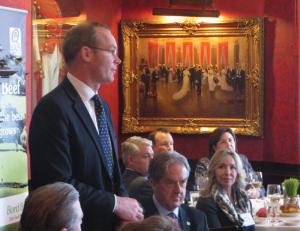March 2, 2015
 Ireland’s Minister for Agriculture, Food and the Marine, Simon Coveney TD, spoke during a luncheon at Smith & Wollensky Steakhouse in the Back Bay last month. Photo by Ed Forry
Ireland’s Minister for Agriculture, Food and the Marine, Simon Coveney TD, spoke during a luncheon at Smith & Wollensky Steakhouse in the Back Bay last month. Photo by Ed Forry
Where’s the beef? That’s the refrain from an old TV hamburger chain commercial that’s gone down in American folklore. But for connoisseurs of natural, grass-fed steaks and roasts from Ireland, that question is amplified: “Where’s the Irish Beef?”
For the last 15 years, as far as the American market is concerned, the answer has been: “Nowhere to be found.”
It has been that long – a full decade and a half – since the USDA banned the importation of Irish beef in the wake of the so-called “Mad Cow disease” epidemic that raged through parts of Europe in 1999-2000. But this past January, the food agency gave the all-clear to Irish beef, and so the product will soon be re-introduced to America, perhaps as soon as this spring.
And so it was that Ireland’s Minister for Agriculture, Food and the Marine, Simon Coveney TD, was joined by officials from the Irish Food Board (Bord Bía) and Irish meat industry officials on a whirlwind three-day visit to New York, Washington, DC, and Boston to launch a campaign hailing the return of Irish beef to the American market.
At a luncheon at Smith & Wollensky Steakhouse in the Back Bay, Coveney was ebullient about the campaign: “We’re here to tell a story about a product that we’re very proud of,” he said. “Accessing the US market for Irish beef is a big deal in Ireland. We are the largest beef exporter in Europe, and we are the largest net exporter in the western hemisphere despite the fact that we come from a very small country.
“We have been aspiring for quite some time to build a reputation as a county that produces the best beef in the world, and if you’re not in the biggest market in the world, and you have that aspiration, well, then, there’s something seriously wrong.”
Coveney was speaking to a luncheon gathering of some 40 local restaurant owners and food buyers, as S&W chefs prepared a sumptuous meal. Featuring a Bord Bía menu entitled “Irish Beef – the flavor shows where the best grass grows,” the guests were served a three-course meal featuring a 20- ounce Irish Beef Rib-eye Steak with whipped potatoes, duck-fat roasted root vegetables, a Wollensky Salad and the restaurant’s famous chocolate cake.
“For us this has been a big effort to work with the USDA to be the first European country to be back in the US market following the banning of European beef,” Coveney said. “Millions of Americans can trace their roots back to a time where their families came from small family farms that are still intact today. But instead of now relying on potato crops, we now have an almost complete reliance in terms of how we produce food on grass.
“And it’s grass that makes Irish beef different, it’s what makes Irish beef taste different; it’s about small family-sized farms with relatively small herds that don’t use any growth promoters or hormones; they simply rely on green grass that grows in abundance in Ireland to produce top quality beef that tastes great and is absolutely natural. And we think that makes our beef quite different.”
“We think there’s a niche for natural beef that consumers are looking for in increasing numbers,” Coveney told the gathering. “We think there’s an opportunity, now at a time when the US herd is smaller than it has been since 1951. That is why I hope that in the not too distant future we’ll see Irish beef on the menu for people who want it.”
Although the product is not yet regularly available, it was understood by those at the gathering that Irish beef will soon be on the menu at both Smith & Wollensky restaurants in Boston.

